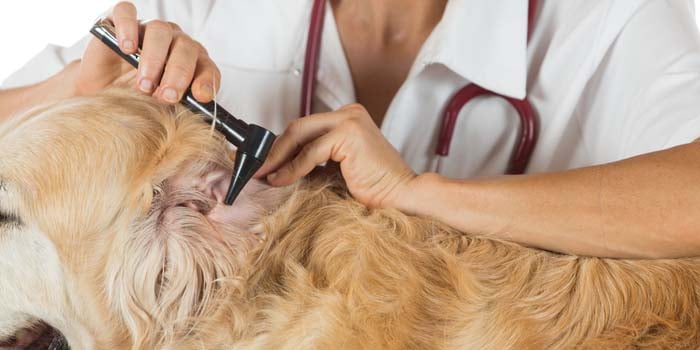
Table of Contents
Knowing how to tell if a dog has an ear infection early on is important to prevent any long-term damage to your dog's ears.
Early detection equals early treatment. When left untreated for too long, well… damages will be inevitable.
An estimated 20% of canines, or a whopping 1 in 5 dogs, suffer from ear diseases, including ear infections.
And because it's common, the silver lining is that they are also easy to spot and treat!
As we know, there are three types of ear infections in dogs:
- Otitis Externa – inflammation of the outer ear canal
- Otitis Media – inflammation of the middle ear
- Otitis Interna – inflammation of the inner ear
The infection almost always starts in the outer ear. When left untreated, it can be dangerous and cause irreversible damage, especially as it moves to the middle and inner parts of the ear.
The most common causes of dog ear infections are:
- Bacteria or yeast overgrowth
- Ear mites (most common in puppies)
- Moisture buildup from swimming or bathing
- Stuck foreign objects in the ear
- Trauma or overcleaning
- Underlying conditions like allergies or hypothyroidism
Because of poor air circulation, dog breeds most at risk are those with floppy, long ears, like Cocker Spaniels and Basset Hounds.
But even if you have a short-eared dog, they will also be prone if they frequently swim, do not dry properly after a bath, or have chronic skin conditions.
RELATED: Dog Ears 101: How to Care for Them and Prevent Problems
How to Tell if a Dog Has an Ear Infection: 10 Signs & Symptoms
There are obvious indicators that your dog is suffering from an ear infection, and you can observe this based on physical and behavioral signs:
- Redness or swelling inside the ear canal
- Visible discharge (brown, yellow, or bloody)
- Foul odor coming from the ears
- Crust or scabs inside and around the ear opening
- Hair loss around the ear
- Constant head shaking
- Scratching or pawing at the ears
- Whining or yelping when the ears are touched
- Shaking or tilting the head to one side
- Disinterest in food or play due to pain
Any or a combination of these signs and symptoms can be a good indicator that your dog is suffering from an ear infection.
How to Do a Quick At-Home Check for Dog Ear Infection
You can quickly inspect your dog's ears at home to see their condition.
- Lift your dog’s ear gently and inspect for redness, discharge, or odor.
- Use a flashlight to check for inflammation deeper in the ear canal.
- Observe your dog’s reaction when you touch or move the ear.
If your dog resists strongly or appears to be in pain, consult a vet immediately.
Suppose the symptoms persist for more than three days, there is visible pus or blood in the ears, a sudden loss of balance or coordination, too much swelling in the ears causing them to close, or your dog's behavior drastically changes.
Those are good indicators that it's time to visit your vet.
Remember: Delayed treatment can lead to chronic infections, hearing loss, or even Vestibular disease in dogs.
RELATED: How To Tell If A Dog Is In Pain
What to Expect at the Vet
The veterinarian will do a series of tests to determine the cause and the proper treatment for your dog's ear infection. They'll likely do the following:
- Physical examination of the ear
- Otoscope exam to view inside the canal
- Cytology swab to identify bacteria or yeast
- In rare cases, X-rays, CT, or MRI scans, especially if the infection is chronic or severe
Depending on the cause, the possible treatments vets might recommend are:
- Antibiotic or antifungal ear drops
- Steroid medications, like prednisone or dexamethasone otic.
- Oral antibiotics
- Ear flushing (only done in the vet's clinic)
- Surgery (only when necessary for extreme cases)
You can check out our Top 5 vet-recommended OTC ear infection treatments at this link.
Follow your vet's instructions closely, especially regarding the dosage (if any) and duration. You must finish the prescribed medication, even if your dog seems better.
Keeping your dog's ears dry and avoiding water exposure is also best. That means no bathing or swimming in the meantime!
If the symptoms recur after medicating, return to the vet.
And one more thing: never use hydrogen peroxide, Q-tips, or rubbing alcohol in your dog's ears, as these can worsen the inflammation.
RELATED: 22 Signs and Symptoms That Require an Immediate Vet Visit
Take Care of Your Dog's Ears to Prevent Infections!
The best way to address this health concern is to prevent dog ear infections from occurring.
You can protect your dog's ear health with extra care and precautions, especially if they're most at risk (as discussed above).
You can do the following:
- Regular cleaning using vet-approved ear cleaners
- Thoroughly drying your dog's ears after bathing or swimming
- Trimming excess hair around the ears
- Regular check-ups with the vet
- Monitoring for seasonal allergies
- Considering hypoallergenic foods, especially for recurring infections
- Omega-3 supplements are given to support skin and coat health.
You can also try these recipes for homemade dog ear cleaners.
Note that this is only recommended for healthy but dirty ears. Do not use these during an ear infection and without your vet's approval!
1. Can a dog ear infection go away on its own?
No, most infections require treatment.
If left untreated, they can worsen or become chronic, and damage not only your dog's ears but also lead to other serious conditions like hearing loss and neurological problems.
2. How long does a dog ear infection take to heal?
With proper treatment, most infections clear up within 1 to 2 weeks.
However, even though the signs seem to have cleared up, it is important to continue the medication as your vet prescribed.
3. Can I use human ear drops on my dog?
No. Human ear drops may contain ineffective and toxic ingredients for dogs. Always make sure to use pet-specific medications as prescribed by your vet!
4. Are ear infections contagious between dogs?
Typically, no. However, if the cause of infection is ear mites, it can spread between pets.
If one of your dogs has ear mites, the best course of action is to isolate the affected animal, clean your environment, and treat all your pets at home.
5. How can I treat my dog's ear infection at home?
You should only treat your dog’s ear infection at home under the guidance of a veterinarian.
Apple cider vinegar and coconut oil are popular home remedies, but they may only be effective for specific causes of dog ear infections.
RELATED: Treating a Dog Ear Infection Using Home Remedies and OTC Aids
6. Can a dog ear infection cause diarrhea?
No, not directly.
But your dog may experience an upset stomach, either because of the pain and discomfort or as a side effect of the oral antibiotics or other medications.
It's best to consult your vet if the diarrhea persists.
How to Tell if a Dog Has an Ear Infection: Before You Go…
Knowing how to tell if a dog has an ear infection can save your pet from a lot of pain and you from expensive vet bills.
Watch out for the key symptoms, act quickly, and keep those ears clean and dry. Your dog will thank you!
Found this post helpful? Share it with fellow dog parents and explore our other articles on canine health and care!















